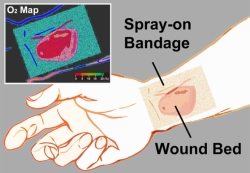
The transparent bandage displays an oxygen-sensitive colormap.
Credit: Li/Wellman Center for Photomedicine
A paint-on, see-through bandage – fully equipped with oxygenation sensors – has been developed with the purpose of better aiding wounded soldiers and improving the success of surgeries to restore limbs and physical functions.
Not only does it protect wounds and burns as any bandage should, but it also enables direct measurement and mapping of tissue oxygen.
The “smart” bandage was developed by an international, multidisciplinary team of researchers led by Assistant Professor Conor L. Evans at the Wellman Center for Photomedicine of Massachusetts Generall Hospital (MGH) and Harvard Medical School (HMS). The group’s findings have been recently published in The Optical Society’s (OSA) open-access journal Biomedical Optics Express.
This from The Optical Society:
Now, the “smart” bandage developed by the team provides direct, noninvasive measurement of tissue oxygenation by combining three simple, compact and inexpensive components: a bright sensor molecule with a long phosphorescence lifetime and appropriate dynamic range; a bandage material compatible with the sensor molecule that conforms to the skin’s surface to form an airtight seal; and an imaging device capable of capturing the oxygen-dependent signals from the bandage with high signal-to-noise ratio.
Not only is the bandage using sensor technology in a new way, but it is also easy to interpret.
“How brightly our phosphorescent molecules emit light depends on how much oxygen is present,” said lead author and HMS research fellow Zongxi Li. “As the concentration of oxygen is reduced, the phosphors glow both longer and more brightly.”
Check out the latest research in the field of sensors via ECS’s Digital Library.
Additionally, much like The Optical Society, ECS stands behind open-access (OA) publication. See what we’re doing to make this bold move toward OA.


